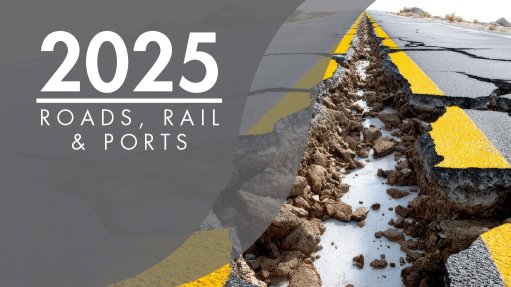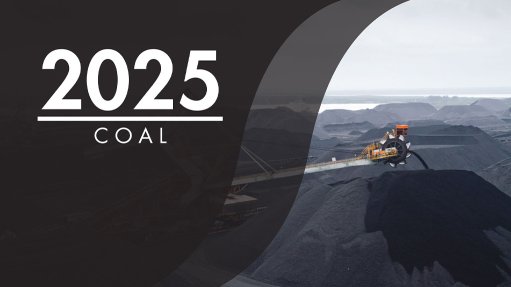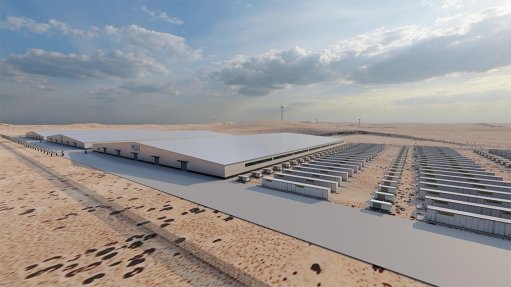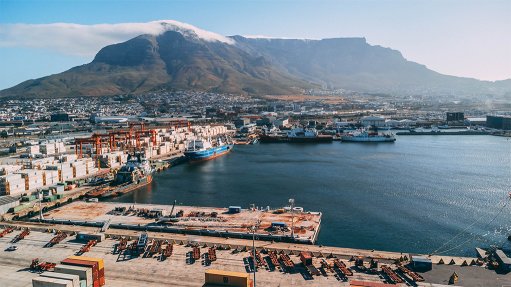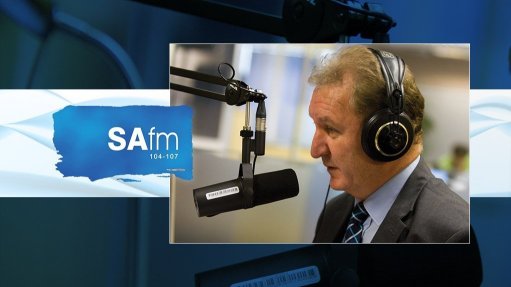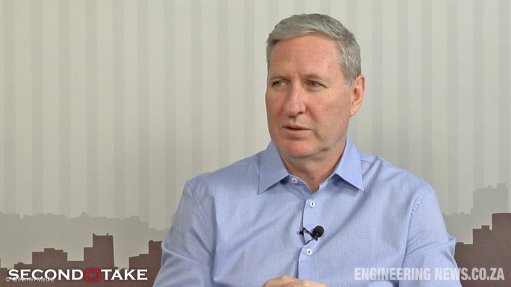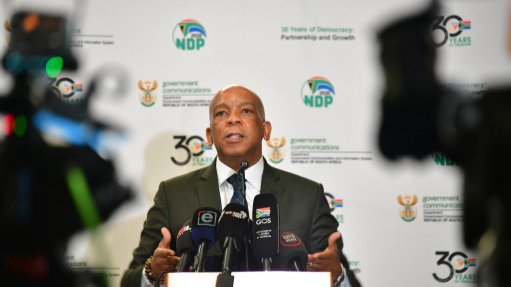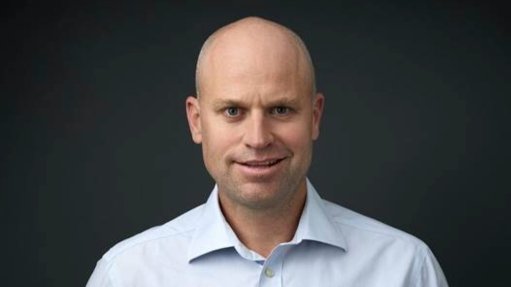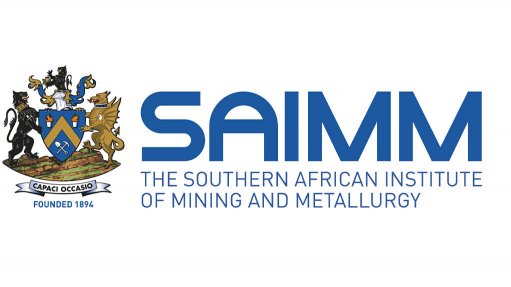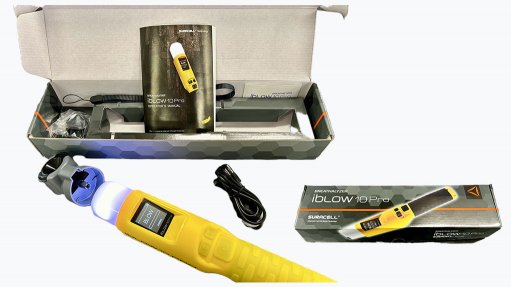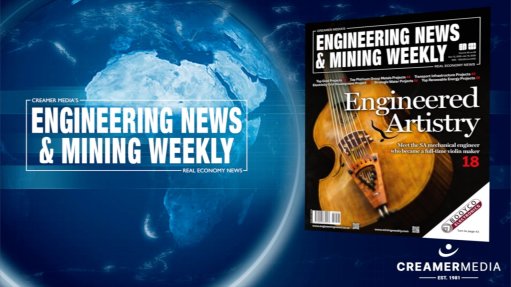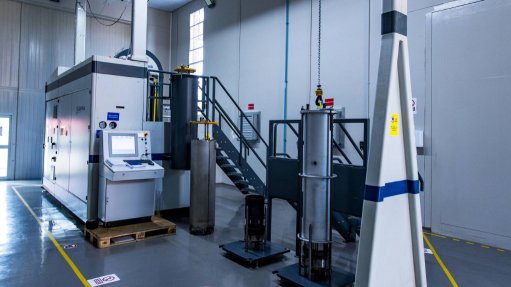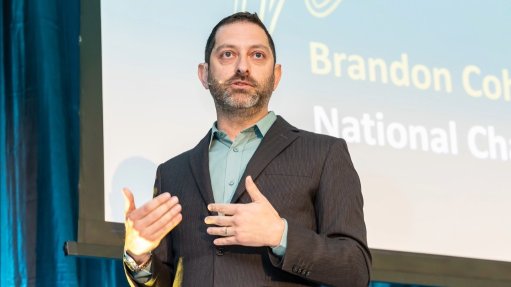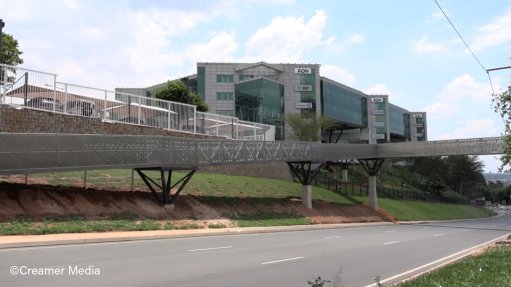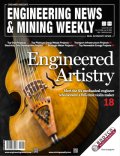‘Exciting’ DRDGOLD projects ‘advancing well’ as 2028 Vision gets big gold price boost

DRDGOLD CEO Niël Pretorius and CFO Riaan Davel interviewed by Mining Weekly's Martin Creamer. Video: Darlene Creamer.
JOHANNESBURG (miningweekly.com) – Johannesburg- and New York-listed DRDGOLD’s projects under way are “advancing very well” as the gold-from-tailings company’s 2028 Vision gets a massive boost from the sky-high gold price.
Mining Weekly discussed this in a Zoom interview with DRDGOLD CEO Niël Pretorius and DRDGOLD CFO Riaan Davel, which we now publish following last week’s declaration of an eighteenth consecutive financial year of dividend payout by the company that on April 25 will celebrate 130 years of being listed on the Johannesburg Stock Exchange. (Also watch attached Creamer Media video.)
The shareholders of DRDGOLD are continuing to benefit from consistently impressive on-surface gold recovery at the 13-year life-of-mine (LoM) Ergo, east of Johannesburg, as well as its rapidly advancing 20-year LoM Far West Gold Recoveries (FWGR) activities west of the Golden City.
“We’re working hard to optimise our existing asset base. Basically what we're doing now is Ergo Two,” Pretorius added in referring to initial life of mine plan for Ergo, acquired in 2007, having been mined out.
Ergo Two’s first new vital thrust is the cost-cutting 60 MW solar power plant at the tailings reprocessing plant, plus the commissioning of a 160 MWh battery energy storage system.
The second part of Ergo Two involves the expansion of the Brakpan tailings storage facility and commissioning of the Withok tailings facility in order to restore the throughput rate back to some 1.8-million tons a month.
That’s the target of Vision 2028, along with a whole new range of resources that will be accessed over the next few years.
At the same time, on the Far West Rand, taking progressive shape are the Far West Gold Recoveries activities involving repurposing and recommissioning the Driefontein Two plant’s throughput to 600 000 t a month, from its consistent current 500 000 t a month.
But, from the outset, work started on the design of the regional tailing storage facility (RTSF), where more than two-million cubic metres of material have been moved from the large 800 ha site.
The second component of the RTSF project is the doubling in size of the Driefontein Two plant to take it to 1.2-million tons a month, and through Vision 28, establishing the capital infrastructure to support a throughput of three-million ton a month.
This is about one-million tons higher than currently. Thereafter gold output will be increased by roughly a ton a year, or 40 000 oz, to take DRDGOLD to more than 200 000 oz, sustaining that for many years to come.
“These are exciting projects. They’re all going well,” Pretorius enthused.
The gold price at record highs is providing the ability to aggressively reinvest into supporting capital infrastructure.
DRDGOLD has spent close to R1-billion on capital infrastructure in the last six months, and has not had to dip into its debt facility set up during the course of last year.
Mining Weekly: How strong is DRDGOLD’s balance sheet and what are its added strength prospects in the light of the record gold price?
Davel: We're very proud of our balance sheet. From 31 December 2023 to 31 December 2024, our property, plant and equipment grew by R3-billion and the majority of that investment has gone into the solar and battery system at Ergo, which is now practically complete. And then, it's strong in that we still have cash in the bank of just over R600-million at the end of December. We’ve always invested in rehabilitation funds or assets on our balance sheet, so it's really a strong foundation for us to grow from and the gold price is really supporting our growth. Our model is brilliant from that point of view, in that we are still operating fully at both Ergo and Far West Gold Recoveries, based on its capacity, and constraints that we want to address in the long term through our capital investment. But the high gold price is helping through those operations for us to prioritise our huge capital expenditure programme of almost R10-billion over the next three to four years, which supports that we don't necessarily need to access other funds. We've told our shareholders that we will prioritise towards our capital programme, but it's then wonderful, in a really good period like this, that we can also return some cash to our shareholders. So, very proud. It's really positioned for growth our balance sheet, and looking forward to growing it further.
Can international surface-mining opportunities by operationalised by DRDGOLD – and if so, how?
Pretorius: It's not an easy model to grow because you don't grow by simply just buying up a whole bunch of old tailings dams across the globe. For one to be able to reclaim a mine dump, a tailings dam, there are a whole host of other things that need to be there as well. Ideally, you would want to have existing capital infrastructure in place, because to build the plants and to set up tailings disposal facilities and to run at the requisite throughput rate requires an enormous amount of capital. Typically, you would want to be in a position, like we've been with Ergo and with Far West Gold Recoveries, where there's an existing plant that you could repurpose and upgrade to set it up for a high throughput profile. You also need lots of water and you need lots of electricity. Ideally, what you want is to become involved in the way that we became involved with Far West Gold Recoveries, where you're almost running in parallel with an existing primary mining operation, before there's been a deterioration in the quality of the existing capital infrastructure. Having said that, there are also not many large enough, concentrated tailings dams in the regions where we've been looking. We’re definitely looking at opportunities, but it will require a collaboration from the current owners of those operations. We believe that we do offer an opportunity. We offer solutions, both in terms of unlocking the latent value of what's still in those old mine dumps, but at the same time also contributing, in some way or another, towards the ultimate closure and rehabilitation of existing mine sites. The old pattern of mining an operation to within eight years of closure, and then offloading it on to a new, emerging operator, is changing because the standards of environment, of environmental governance, have changed. Things have become more visible. There are better standards of transparency nowadays. Notwithstanding that an operation may be tucked away somewhere in a jungle, it still gets found, and your legacy is still witnessed. If it's bad legacy, it's obviously the sort of thing that that doesn't sit well considering the sort of undertakings that are nowadays being given by major operators in terms of closure rehabilitation, standards of environmental governance and so forth. Many of those operations aren't set up to bring about closure. The typical model is to offload an operation towards the end of its life. We could offer a solution by partnering with some of those operations and coming in at some point or another and saying, alright, from an ecosystem restoration perspective, from an improvement and an increase in restoring biodiversity, instead of you having to dip into your existing operating cash flows to do that, because clearly, these have been inadequately provided for, we can unlock some of the remaining value in there. From a collaboration perspective, there's that opportunity. It's not one that we've been able to unlock successfully. Sibanye-Stillwater has been our only success up until now. But there are conversations, and most of these conversations occur well, but it's in the putting these into effect. We’re having conversations, we’re assessing the quality of assets and so forth, and then we're hoping to become involved in conversations that will hopefully open up some doors for us. In the meantime, though, we've got more than enough to keep ourselves busy, so whilst the opportunity is there, the ability is there, the willingness is there, there's also the reality of having to make sure that we deliver into these very complex capital reinvestment programmes that we're involved in right now. We’re very happy that the solar has been successfully commissioned. But there's some other things that we need to finish as well. The RTSF is a very large facility. It's on a tight timeline. There are also interactions with regulators and so forth that need to be done. The same applies to Withok, the plant upgrade. It's more of an engineering thing, and we've shown ourselves to be capable of building these things to a very high standard, and they work, but still it requires very close attention, and we don't want to be distracted unnecessarily.
Has there been any success in your looking beyond gold to copper and platinum opportunities?
There is a project that our team has managed to construct out of assets that were regarded as non-core. It's a compelling project, and we did that in collaboration with Sibanye-Stillwater. But ultimately, it’s Sibanye-Stillwater's decision, whether or not we're going to be involved in that. It's a company which, at this stage, is very busy. It's got lots of moving parts, so it will happen as and when Sibanye-Stillwater decides that it's a good time for it to happen. They may want to do it themselves as well. There's no reason why they couldn't. The design is elegant and our team has articulated the way to implement it really well. In terms of assets that we would want to acquire, we would want to do that in the copper and gold space. We understand gold, we’re comfortable with gold. We consider ourselves to be a gold miner and we talk about sustainable gold. But copper would also be a good one, and we know that there are vast copper deposits, on this continent and elsewhere, which could be developed over time. In terms of other metals, there really I think it would be a collaboration or we would serve as an expert service provider, as a consultant, but maybe an operational consultant to assist other operators to the extent that they believe that they can benefit from our value proposition, to set up infrastructure, to unlock the income generating potential of dormant stockpiles, waste stockpiles, and to apply that towards environmental restoration and the re-establishment of the original ecosystems and biodiversity. We've seen that at the Brakpan tailings facility. It's a wonderful biodiversity story. We've never not been busy cladding the sidewalls of that facility. It's a very gentle slope, and it keeps up with the raising of the tailing dam. We’ve cladded it with natural soil, and because of natural soil, natural vegetation came back, and it was just fantastic to see how nature restored itself, insects and rodents and reptile, snakes, jackal, warthog, birds. They don't know that this is an artificial facility. They’re experiencing natural vegetation. It's a waste dump, but it's also almost like a green lung on the east of Johannesburg, and it's lovely to witness that. We don’t just have a concept. We can actually go and show them what it looks like, what the final resting place of your mine waste can look like if you're not in a position to backfill, as well as all of the sites that we've restored and that are now being put back into sustainable land use, in and around the Johannesburg area. It’s in excess of 2 000 ha of land, in and around the Johannesburg, that has been restored, and the intention is to add several more hundred hectares over the next 15 to 18 years. Some tailings dams are in environmentally sensitive locations, right next to vast wetlands and other areas are close to where people live.
What is the DRDGOLD debt position, how does it go about funding South African projects and how could it go about funding international ones if they cropped up?
Davel: I’m very, very happy to report that our external debt position is still zero, but we have a facility with Nedbank, secured last year, that's in place for five years, which sort of matches our medium-term and Vision 2028 capital programme of R2-billion. The idea around that is to support the R10-billion Vision 2028 capital expansion programme on both the Far West Rand Gold Recoveries and also at Ergo. If the gold price stays at this level, we may not even access the facility fully, but I think that it’s good business to have it in place while we tackle that expansive capital project programme.
Funding international opportunities will depend on whether or not those opportunities come about. We have two long-standing listings on both the Johannesburg Stock Exchange and also on the New York Stock Exchange. We're so proud to say that this year, on the 25th of April, we will be celebrating 130 years on the JSE. Obviously, we can access those capital markets if there's an opportunity that arises but that's not something that we’re considering at the moment. We believe our R2-billion Nedbank debt facility is sufficient to see us through in the medium term, executing our South African opportunities.
DRDGOLD last year transferred an agriculture entrepreneurship project to a community near its Ergo mining operation, as part of creating self-sustaining livelihoods. How much of this is possible and what are the big environmental and urban property spinoffs?
Pretorius: Most of our reclamation sites are in close proximity to established communities and oftentimes these communities are facing hardship. Many of them are communities where there are high levels of unemployment, not the best of infrastructure and so forth. In some instances, one gets the sense that they're forgotten communities, that they're not being prioritised in terms of services and so forth. We collaborated with the University of Pretoria a few years ago on what a self-empowerment programme for communities like that could look like. They came up with 40 initiatives that are essentially programmes of self-empowerment and we’re systematically rolling out those programmes. I think this year, about six have been implemented and are now being advanced. They start with how to bring a healthy baby into this world, how to make sure that your child is ready for school, and they end with people at the other side of the life cycle, quality of life for the elderly, access to services and better mobility, etc. It’s a very ambitious programme, but the information is there, and it relies, by and large, on buy-in from communities themselves. It's about equipping communities with knowledge.
The agricultural initiative was one we intuitively decided on. We plant stuff and we cultivate stuff and we consume the product, but it's also got to be lifted to the next level. Ultimately, you want to change the optics and the quality of life of those communities. What you’re really doing is providing information and methodologies. Ideally, ultimately, we want these communities to become self-sustainable, to leverage the inflow of social grants on a monthly basis, and to re-invest that into their own micro, informal economy, and to be less and less dependent on external assistance. It's a marathon, not a sprint, but we’re seeing how more and more members of those communities are attending life skills courses, how they are signing up for some of these other initiatives as well, and how they take that back into their communities. Hopefully, by doing this, you are establishing an increasing number of little pockets of stability, and as these expand, larger portions of that community could also become more and more stable. Obviously, the government can't just abrogate all responsibility. They do need to make sure that those communities are safe, so they are going to have to do something about crime, and are going to have to do something about the influx of people who come and establish themselves in areas where those communities live, as a platform for crime, and also the illegal mining of what remains of our national resources. But that too is an ongoing process. We are seeing a significant uptake of what we're making available. Our teams are very committed, very determined to do that.
What I also like about the model and something that’s not always recognised, is the vast property portfolio that DRDGOLD has. Because DRDGOLD has been around for 130 years, it has acquired properties over many decades. If you look at the amount of money that is invested in these social programmes, and you look at the amount of money that we're generating from the making available of property over time, a very small percentage is funded out of gold revenues. In the longer term, if you net off what we get from non-gold assets and what we're getting from our gold sales. I think that DRDGOLD has also distinguished itself very uniquely as an enterprise where it has a compelling sustainable development capital value creation in terms of, let's call it, the softer environment and social capital stocks, but it’s not coming at the cost of shareholder income. It's not diluting shareholder income. This is being done by way of non-core sources of income, which are probably not even recognised by the market. You don't buy DRDGOLD shares because we have properties. You buy DRDGOLD shares because we produce gold, and I think a unique feature of our company is that we make property available in this way and support communities in this way.
GOLD PRICE
In the six months to 31 December 2024, the gold price averaged by DRDGOLD was a 26%-higher R1 478 663/kg amid operating profit leaping 74% to R1 578.7-million and headline earnings darting 65% to just under R1-billion.
The interim dividend declared was 50% higher than last year’s corresponding half-year payout.
Production guidance for financial year 2025, which ends on June 30, is unchanged at between 155 000 oz and 165 000 oz of gold at a cash operating cost of some R870 000/kg.
Vision 2028’s target is to sustain a throughput rate of three-million tons a month, up from just over two-million tons currently, and to take gold production up from just north of five tons a year to six tons a year, which is over 200 000 oz/y.
The Withok tailings dam, a licensed site, is designed for 310-million tons.
Article Enquiry
Email Article
Save Article
Feedback
To advertise email advertising@creamermedia.co.za or click here
Comments
Press Office
Announcements
What's On
Subscribe to improve your user experience...
Option 1 (equivalent of R125 a month):
Receive a weekly copy of Creamer Media's Engineering News & Mining Weekly magazine
(print copy for those in South Africa and e-magazine for those outside of South Africa)
Receive daily email newsletters
Access to full search results
Access archive of magazine back copies
Access to Projects in Progress
Access to ONE Research Report of your choice in PDF format
Option 2 (equivalent of R375 a month):
All benefits from Option 1
PLUS
Access to Creamer Media's Research Channel Africa for ALL Research Reports, in PDF format, on various industrial and mining sectors
including Electricity; Water; Energy Transition; Hydrogen; Roads, Rail and Ports; Coal; Gold; Platinum; Battery Metals; etc.
Already a subscriber?
Forgotten your password?
Receive weekly copy of Creamer Media's Engineering News & Mining Weekly magazine (print copy for those in South Africa and e-magazine for those outside of South Africa)
➕
Recieve daily email newsletters
➕
Access to full search results
➕
Access archive of magazine back copies
➕
Access to Projects in Progress
➕
Access to ONE Research Report of your choice in PDF format
RESEARCH CHANNEL AFRICA
R4500 (equivalent of R375 a month)
SUBSCRIBEAll benefits from Option 1
➕
Access to Creamer Media's Research Channel Africa for ALL Research Reports on various industrial and mining sectors, in PDF format, including on:
Electricity
➕
Water
➕
Energy Transition
➕
Hydrogen
➕
Roads, Rail and Ports
➕
Coal
➕
Gold
➕
Platinum
➕
Battery Metals
➕
etc.
Receive all benefits from Option 1 or Option 2 delivered to numerous people at your company
➕
Multiple User names and Passwords for simultaneous log-ins
➕
Intranet integration access to all in your organisation





